Download IGNOU MAEC Project (MECP 101/102)
The IGNOU MAEC Project (MECP 101/102) is a crucial component of the Master of Arts in Economics (MAEC) program offered by Indira Gandhi National Open University (IGNOU). IGNOU MAEC Project (MECP 101/102) designed to help you apply the theoretical knowledge gained during the coursework to real-world scenarios.
MAEC Project work is an academic activity that focuses on using theoretical and mathematical abilities learned from courses in MA Economics, namely MEC-001, MEC-002, MEC-003, and MEC-109. Its purpose is to enhance your ability to apply theoretical knowledge in practical situations. The project work will provide you with the opportunity to analyze the diverse economic events and situations encountered in real-world scenarios. Essentially, it involves utilizing the knowledge acquired from different courses to analyze and address the economic difficulties and concerns that arise in everyday situations.
This IGNOU MAEC Project project has a credit value of six and requires around 180 hours of work to complete. We would appreciate it if you could provide us with a printed and bound version of your Project Report. The acceptable range for the length of your Project Report is 15000-20000 words, which is equivalent to 50-60 pages. Consider this factor when selecting the project theme. The concept is that you should be capable of expressing everything you desire to communicate within the confines of this word limit. You have the option to write your Project Report in either English or Hindi.
Whatsapp us to get the Personalized (Customized) or Readymade IGNOU MAEC Project Report or MAEC Synopsis
IGNOU MAEC Project Topics (MECP 101/102)
- Impact Of Mahatma Gandhi National Rural Employment Guarantee Act (Mgnrega) On Rural Livelihoods
- Role Of Ngos In Imparting Education Among Women
- Corporate Governance In Telecom Sector: A Theoretical Study
- Role Of Communication For The Development Of Rural Women With Special Reference To Self Help Group
- Consumer Behaviour In The Gold Jewellery Market
- Importance Of Rural Banks In The Rural Areas
How long does it take to get the IGNOU MAEC Project Proposal (MECP 101/102) approved?
The approval time for your IGNOU MAEC project proposal (MECP 101/102) generally falls within eight weeks after the School receives it.
Here’s a breakdown of the information:
- IGNOU doesn’t specify an exact timeframe, but sources suggest an eight-week window [All about IGNOU Project Proposal – Synopsis Submission and Approval, Scribd].
However, it’s important to consider these additional factors that might influence the approval time:
- Workload of the School: If the School is processing a large number of proposals at once, yours might take a little longer.
- Completeness of your proposal: A well-structured and clear proposal with all required elements is more likely to get a quicker approval.
- Revisions needed: If your proposal requires revisions based on feedback from the School, the approval process will take longer until you submit a revised version.
Tips for a smoother approval process:
- Ensure you thoroughly understand the IGNOU project guide and follow its guidelines for proposal structure and content.
- Discuss your topic choice with your study center Program In-charge beforehand to get their initial feedback.
- Submit a well-written and organized proposal that clearly outlines your research objectives, methodology, and expected outcomes.
Can you use secondary data for your IGNOU MAEC Project (MECP 101/102)?
Yes, you can definitely use secondary data for your IGNOU MAEC project. In fact, using secondary data is a common and often preferred approach for these projects.
Here’s why secondary data can be a good choice:
- Accessibility: Existing data from reliable sources is readily available, saving you time and resources required for primary data collection (surveys, interviews, etc.).
- Cost-effectiveness: Secondary data is usually free or has minimal access costs compared to conducting your own survey or experiment.
- Breadth of Information: Secondary data sources may offer vast amounts of data over a longer period, providing valuable historical context for your analysis.
However, there are some limitations to consider when using secondary data:
- Relevance: Ensure the data directly addresses your research question and is from a credible source.
- Timeliness: Check the data’s publication date for its relevance to your current study.
- Data Quality: Critically evaluate the data’s collection methodology and potential biases.
Here are some resources for finding reliable secondary data for your project:
- Government Websites: Many Indian government agencies like the Ministry of Statistics and Programme Implementation (MOSPI), Reserve Bank of India (RBI), and National Sample Survey Organization (NSSO) provide extensive economic data.
- International Organizations: World Bank, International Monetary Fund (IMF), and OECD (Organization for Economic Co-operation and Development) offer global and regional economic statistics.
- Research Institutions: Reports and data published by reputable institutions like National Council of Applied Economic Research (NCAER) and Centre for Monitoring Indian Economy (CMIE) can be valuable sources.
What are the formatting requirements for the IGNOU MAEC Project Report (MECP 101/102)?
IGNOU provides a project guide to assist you with formatting your MAEC project report (MECP 101/102) but doesn’t have a strict page limit. Here’s a general outline of the recommended formatting:
- Font and Size: Use a standard font like Times New Roman or Arial, size 12-14 points for the body text.
- Spacing: Double line spacing is generally preferred for readability.
- Margins: Maintain margins of at least 1 inch on all sides of the page (A4 size paper).
- Page Numbering: Start numbering consecutively from the Introduction section (typically page 3 after the initial pages).
- Headings and Subheadings: Use a clear hierarchy of headings and subheadings to structure your report.
Here’s a possible breakdown of the structure for your report:
- Title Page: Include project title, your name, enrollment number, year, and IGNOU details (as specified in the project guide).
- Certificate: A declaration stating the originality of your work and the guidance received.
- Acknowledgement: Express gratitude to those who supported your research.
- Table of Contents: Provide a clear and detailed list of sections and their corresponding page numbers.
- Introduction: Briefly introduce the research topic, its significance, research objectives, and methodology.
- Review of Literature: Summarize existing research and relevant literature related to your topic.
- Methodology: Detail your research design, data collection methods (both secondary and primary, if applicable), and data analysis techniques.
- Results and Discussion: Present your findings from the data analysis and discuss their interpretation in relation to your research objectives and the existing literature.
- Conclusion: Summarize your key findings, reiterate the significance of your research, and suggest potential areas for further study.
- References: List all sources you cited in the report using a standard referencing style (e.g., APA).
- Appendices (Optional): Include any supplementary materials like questionnaires, data tables, or detailed calculations that don’t necessarily fit within the main body of the report.
How do you handle difficulties during your IGNOU MAEC Project Research (MECP 101/102) process?
Research is a process filled with discovery, but it also comes with its own set of challenges. Here are some tips to help you handle difficulties during your IGNOU MAEC project:
Finding the problem:
- Identify the problem: The first step is to identify the exact problem you’re having. Is it narrowing down your study topic, getting stuck on what to write, or having trouble finding relevant data?
- Look at the cause: After you find the problem, try to figure out why it’s there. Are there gaps in your understanding, a lack of data, unexpected results, or trouble organizing your thoughts?
Ways to solve the problem:
- Ask for Help: If you need help, don’t be afraid to talk to your boss or project guide at the IGNOU study center. They can give you useful information and help you deal with problems in your study.
- Use tools: The IGNOU library and online tools can save your life. Read relevant textbooks, academic papers, and online databases to find new data sources or fill in gaps in your knowledge.
- Refine your Approach: If the first ways you tried to collect data aren’t working, you might want to try different methods or change your research questions so they are more in line with the data you already have.
- Talk it over with your peers: Talking to other students or researchers about the problems you’re having with your study can help you come up with new ideas and solutions.
- Take breaks and rest: Research can be hard on the mind. Take breaks to keep from getting burned out, and then begin your work again with a fresh mind.
What should you include in the conclusion section?
The conclusion section of your IGNOU MAEC project report (MECP 101/102) should act as a summary of your research journey and its key takeaways. Here’s a breakdown of what you should include:
1. Restatement of the Thesis:
- Briefly remind the reader of your research topic and the central question you aimed to answer.
2. Summary of Key Findings:
- Highlight the main results and insights you obtained from your data analysis.
- Briefly explain how these findings address your research objectives.
3. Reiterating the Significance:
- Emphasize the importance of your research. How do your findings contribute to the existing body of knowledge in economics?
- Are there any real-world implications or policy recommendations based on your results?
4. Limitations and Future Research:
- Acknowledge any limitations of your study, such as data constraints, methodological choices, or the scope of your research.
- Suggest potential areas for further research that could build upon your findings and address the limitations you identified.
5. Concluding Statement:
- Provide a final takeaway message that leaves a lasting impression on the reader.
- Briefly summarize the overall significance of your research and its contribution to the field of economics.
Here are some additional tips for writing a strong conclusion section:
- Maintain a concise and focused approach. Avoid introducing new information or arguments in the conclusion.
- Use clear and concise language. Restate your findings and significance in a way that is easy for the reader to understand.
- Proofread carefully for any errors in grammar or spelling.
Can you include charts and graphs in your IGNOU MAEC Project Report (MECP 101/102)?
Yes, including charts, graphs, and tables in your project report is highly encouraged. Visual aids can significantly enhance the presentation of your data and make complex information more accessible. Here are some guidelines on how to effectively incorporate these elements:
Guidelines for Including Charts and Graphs
- Relevance: Ensure that each chart or graph is directly related to the content and objectives of your project. Avoid adding unnecessary visuals.
- Clarity: Charts and graphs should be easy to understand. Use clear labels, titles, and legends to explain the data being presented.
- Consistency: Maintain a consistent style throughout your report. Use the same fonts, colors, and formats for all visuals.
- Integration: Integrate charts and graphs into the text. Refer to them in your discussion and explain their significance. For example, “As shown in Figure 1, the GDP growth rate has fluctuated over the past decade.”
- Quality: Use high-resolution images to ensure clarity. Blurry or pixelated visuals can detract from the professionalism of your report.
- Sources: If you are using data from external sources, make sure to properly cite them. Include the source below the chart or graph and in your references section.
- Numbering: Number your charts and graphs sequentially (e.g., Figure 1, Figure 2, Table 1). This helps in easily referring to them in the text.
- Appendices: If you have numerous charts and graphs, consider placing some in the appendices. Reference these in the main text as needed.
Types of Charts and Graphs
- Bar Charts: Useful for comparing quantities across different categories.
- Line Graphs: Ideal for showing trends over time.
- Pie Charts: Effective for illustrating proportions and percentages.
- Scatter Plots: Good for showing relationships between two variables.
- Histograms: Used to display the distribution of a dataset.
Get your IGNOU MAEC Project Synopsis & Report Sample PDF
- Call us or WhatsApp us at: 9958947060, 9354637830
- Visit: SHRICHAKRADHAR.COM
-
Sale!
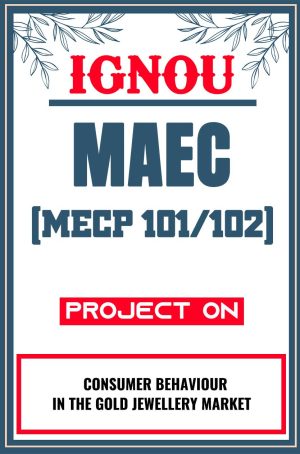
-
Sale!
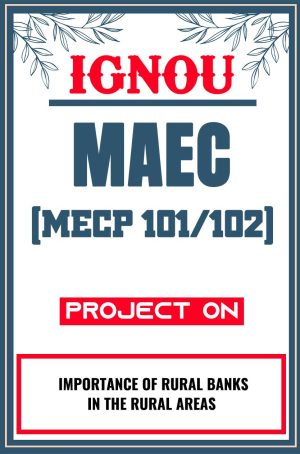
IGNOU MAEC Project (MECP 101/102) Synopsis/Proposal & Project Report/Dissertation in Soft-Copy (Sample-6)
Original price was: ₹499.00.₹149.00Current price is: ₹149.00. -
Sale!
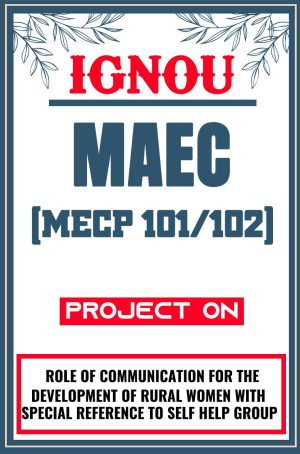
IGNOU MAEC Project (MECP 101/102) Synopsis/Proposal & Project Report/Dissertation in Soft-Copy (Sample-4)
Original price was: ₹499.00.₹149.00Current price is: ₹149.00. -
Sale!
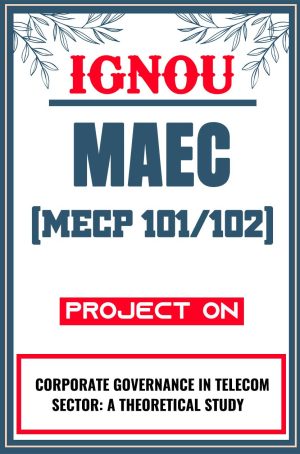
IGNOU MAEC Project (MECP 101/102) Synopsis/Proposal & Project Report/Dissertation in Soft-Copy (Sample-3)
Original price was: ₹500.00.₹149.00Current price is: ₹149.00. -
Sale!

IGNOU MAEC Project (MECP 101/102) Synopsis/Proposal & Project Report/Dissertation in Soft-Copy (Sample-2)
Original price was: ₹500.00.₹149.00Current price is: ₹149.00. -
Sale!
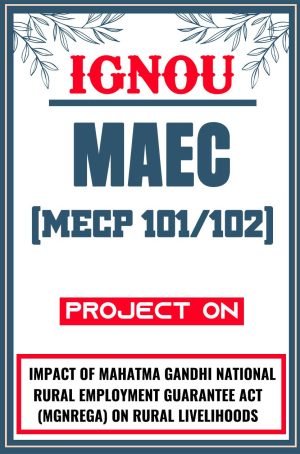
IGNOU MAEC Project (MECP 101/102) Synopsis/Proposal & Project Report/Dissertation in Soft-Copy (Sample-1)
Original price was: ₹500.00.₹149.00Current price is: ₹149.00.
